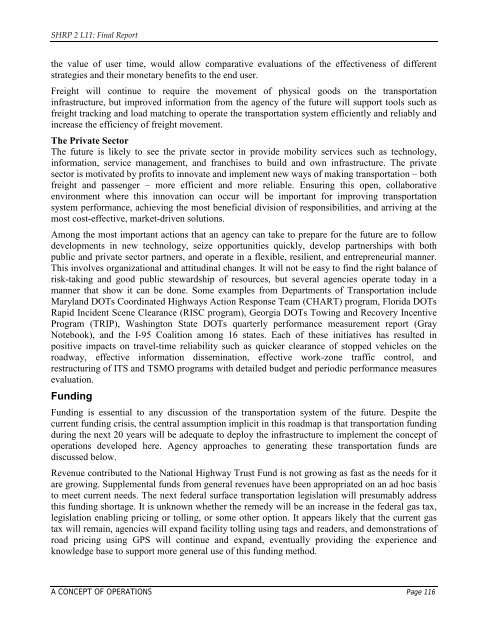Evaluating Alternative Operations Strategies to Improve Travel Time ...
Evaluating Alternative Operations Strategies to Improve Travel Time ...
Evaluating Alternative Operations Strategies to Improve Travel Time ...
You also want an ePaper? Increase the reach of your titles
YUMPU automatically turns print PDFs into web optimized ePapers that Google loves.
SHRP 2 L11: Final Report<br />
the value of user time, would allow comparative evaluations of the effectiveness of different<br />
strategies and their monetary benefits <strong>to</strong> the end user.<br />
Freight will continue <strong>to</strong> require the movement of physical goods on the transportation<br />
infrastructure, but improved information from the agency of the future will support <strong>to</strong>ols such as<br />
freight tracking and load matching <strong>to</strong> operate the transportation system efficiently and reliably and<br />
increase the efficiency of freight movement.<br />
The Private Sec<strong>to</strong>r<br />
The future is likely <strong>to</strong> see the private sec<strong>to</strong>r in provide mobility services such as technology,<br />
information, service management, and franchises <strong>to</strong> build and own infrastructure. The private<br />
sec<strong>to</strong>r is motivated by profits <strong>to</strong> innovate and implement new ways of making transportation – both<br />
freight and passenger – more efficient and more reliable. Ensuring this open, collaborative<br />
environment where this innovation can occur will be important for improving transportation<br />
system performance, achieving the most beneficial division of responsibilities, and arriving at the<br />
most cost-effective, market-driven solutions.<br />
Among the most important actions that an agency can take <strong>to</strong> prepare for the future are <strong>to</strong> follow<br />
developments in new technology, seize opportunities quickly, develop partnerships with both<br />
public and private sec<strong>to</strong>r partners, and operate in a flexible, resilient, and entrepreneurial manner.<br />
This involves organizational and attitudinal changes. It will not be easy <strong>to</strong> find the right balance of<br />
risk-taking and good public stewardship of resources, but several agencies operate <strong>to</strong>day in a<br />
manner that show it can be done. Some examples from Departments of Transportation include<br />
Maryland DOTs Coordinated Highways Action Response Team (CHART) program, Florida DOTs<br />
Rapid Incident Scene Clearance (RISC program), Georgia DOTs Towing and Recovery Incentive<br />
Program (TRIP), Washing<strong>to</strong>n State DOTs quarterly performance measurement report (Gray<br />
Notebook), and the I-95 Coalition among 16 states. Each of these initiatives has resulted in<br />
positive impacts on travel-time reliability such as quicker clearance of s<strong>to</strong>pped vehicles on the<br />
roadway, effective information dissemination, effective work-zone traffic control, and<br />
restructuring of ITS and TSMO programs with detailed budget and periodic performance measures<br />
evaluation.<br />
Funding<br />
Funding is essential <strong>to</strong> any discussion of the transportation system of the future. Despite the<br />
current funding crisis, the central assumption implicit in this roadmap is that transportation funding<br />
during the next 20 years will be adequate <strong>to</strong> deploy the infrastructure <strong>to</strong> implement the concept of<br />
operations developed here. Agency approaches <strong>to</strong> generating these transportation funds are<br />
discussed below.<br />
Revenue contributed <strong>to</strong> the National Highway Trust Fund is not growing as fast as the needs for it<br />
are growing. Supplemental funds from general revenues have been appropriated on an ad hoc basis<br />
<strong>to</strong> meet current needs. The next federal surface transportation legislation will presumably address<br />
this funding shortage. It is unknown whether the remedy will be an increase in the federal gas tax,<br />
legislation enabling pricing or <strong>to</strong>lling, or some other option. It appears likely that the current gas<br />
tax will remain, agencies will expand facility <strong>to</strong>lling using tags and readers, and demonstrations of<br />
road pricing using GPS will continue and expand, eventually providing the experience and<br />
knowledge base <strong>to</strong> support more general use of this funding method.<br />
A CONCEPT OF OPERATIONS Page 116















